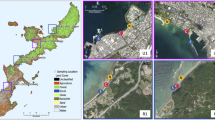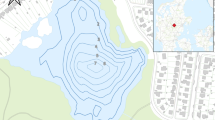Abstract
Because of their location at the interface between sea and emerged lands, so-called transitional environments are characterized by strong spatial and temporal variability in terms of sedimentological, physicochemical, and geochemical parameters. An increasing number of studies put forward the use of bioindicators as a tool for environmental monitoring. However, the sensitivity to these environmental parameters is commonly tested separately, even though it is known that interactions are numerous within this complex ecosystem. An integrated methodological study was conducted in Lake Varano (Italy). On the basis of 45 spatially distributed samples throughout the area and selected environmental parameters (trace elements, organic matter, clay mineral assemblages, grain size of sediment, and water characteristics), four factors are identified. The Lake Varano ecosystem is predominantly influenced by terrigenous inputs (first-order factor). The clastic fractions of the sediments supply a large range of trace elements, occasionally in relatively high concentrations. Under such circumstances, despite occasionally exceeding of threshold limits, the trace element pollution can generally be ruled out. The organic content combined with depth is the second key factor. In Lake Varano, the organic content is high and may lead to seasonal eutrophication. As a third-order factor, although only analyzed once, oxygen, ORP, salinity, and pH gradients show that foraminiferal diversity is positively influenced by more saline conditions. The fourth-order factor is the sediment size. To conclude, this paper illustrates the interest in and need to conduct a detailed, integrated, sedimentological study of a site prior to any examination of its ecological status (possible occurrences of sources of pollution).







Similar content being viewed by others
References
Alve E (1995) Benthic foraminiferal responses to estuarine pollution: a review. J Foraminifer Res 25:190–203
Alve E, Murray JW (1999) Marginal marine environments of the Skagerrak and Kattegat: a baseline study of living (stained) benthic foraminiferal ecology. Palaeogeogr Palaeoclimatol Palaeoecol 146:171–193
Armynot du Châtelet E, Bout-Roumazeilles V, Riboulleau A, Trentesaux A (2009a) Sediment (grain size and clay mineralogy) and organic matter quality control on living benthic foraminifera. Rev Micropaleontol 52:75–84
Armynot du Châtelet E, Degré D, Sauriau P-G, Debenay J-P (2009b) Distribution of living benthic foraminifera in relation with environmental variables within the Aiguillon cove (Atlantic coast, France): improving knowledge for paleoecological interpretation. Bull Soc Geol France 180:131–144
Armynot du Châtelet E, Gebhardt K, Langer MR (2011) Coastal pollution monitoring: foraminifera as tracers of environmental perturbation in the port of Boulogne-sur-Mer (Northern France). Neues Jahrbuch für Geologie und Paläontologie-Abhandlungen 262:91–116
Armynot du Châtelet E, Frontalini F, Guillot F, Recourt P, Ventalon S (2013) Surface analysis of agglutinated benthic foraminifera through ESEM-EDS and Raman analyses: an expeditious approach for tracing mineral diversity. Mar Micropaleontol 105(18–29):18–29
Barnes RSK (1991) European estuaries and lagoons: a personal overview of problems and possibilities for conservation and management. Aquat Conserv 1:79–87
Baxter SJ, Oliver JD (2005) The spatial prediction of soil mineral N and potentially available N using elevation. Geoderma 128:325–339
Belmonte G, Scirocco T, Denitto F (2011) Zooplankton composition in Lake Varano (Adriatic Sea coast, Italy). Ital J Zool 78:370–378
Bertazzon S, Micheletti C, Critto A, Marcomini A (2006) Spatial analysis in ecological risk assessment: pollutant bioaccumulation in clams Tapes philipinarum in the Venetian lagoon (Italy). Comput Environ Urban Syst 30:880–904
Bout-Roumazeilles V, Cortijo E, Labeyrie L, Debrabant P (1999) Clay mineral evidence of nepheloid layer contribution to the Heinrich layers in the Northwest Atlantic. Palaeogeogr Palaeoclimateol Palaeoecol 146:211–228
Breber P, Scirocco T (1998) Open-sea mussel farming in Southern Italy. Eastfish Magazine 22:36–38
Brindley GW, Brown G (1980) Crystal structures of clay minerals and their X-ray identification. Mineralogical Society, London
Carroll ZL, Oliver MA (2005) Exploring the spatial relations between soil physical properties and apparent electrical conductivity. Geoderma 128:354–374
Chamley H (1989) Clay sedimentology. Spinger, Berlin
Dauvin J-C, Ruellet T (2009) The estuarine quality paradox: is it possible to define an ecological quality status for specific modified and naturally stressed estuarine ecosystems? Mar Pollut Bull 59:38–47
DM 56/2009, The Italian guide line DM 56/2009: Decreto del Ministero dell’Ambiente, e della Tutela del Territorio e del Mare, n° 56, 14 Aprile 2009. Regolamento recante «Criteri tecnici per il monitoraggio dei corpi idrici e l’identificazione delle condizioni di riferimento per la modifica delle norme tecniche del decreto legislativo 3 aprile 2006, n. 152, recante Norme in materia ambientale, predisposto ai sensi dell’articolo 75, comma 3, del decreto legislativo medesimo». (09G0065) (GU SerieGenerale n.124 del 30-5-2009—Suppl. Ordinario n. 83)
Esquevin J (1969) Influence de la composition chimique des argiles sur la cristallinité. Bull Centre Rech Pau—SNPA 3:147–154
Frontalini F, Coccioni R (2011) Benthic foraminifera as bioindicators of pollution: a review of Italian research over the last three decades. Rev Micropaléontol 54:115–127
Frontalini F, Armynot du Châtelet E, Debenay J-P, Coccioni R, Bancalà G (2011a) Benthicforaminifera in coastallagoons: distributional patterns and biomonitoring implications. In: Friedman AG (ed) Lagoons: biology, management and environmental impact. Nova Science Publishers Inc., New York, pp 39–72
Frontalini F, Semprucci F, Coccioni R, Balsamo M, Bittoni P, Covazzi-Harriage A (2011b) On the quantitative distribution and community structure of the meio and macrofaunal communities in the coastal area of the Central Adriatic Sea (Italy). Environ Monit Assess 180:325–344. doi:10.1007/s10661-010-1791-y
Frontalini F, Margaritelli G, Francescangeli F, Rettori R, Armynot du Châtelet E, Coccioni R (2013) Benthic foraminiferal assemblages and biotopes of a coastal lake: the case study of Lake Varano (southern Italy). Acta Protozool 52:147–160
Frontalini F, Semprucci F, Armynot du Châtelet E, Francescangeli F, Margaritelli G, Rettori R, Spagnoli F, Balsamo M, Coccioni R (2014) Biodiversity trends of the meiofaunal and foraminiferal assemblages of Lake Varano (southern Italy). Proc Biol Soc Wash 127:7–22
Hayward BW, Grenfell H, Cairns G, Smith A (1996) Environmental controls on benthic foraminiferal and thecamoebian associations in a New Zealand tidal inlet. J Foraminifer Res 26:150–171
Hayward BW, Scott GH, Grenfell HR, Carter R, Lipps JH (2004) Estimation of tidal elevation and salinity histories of sheltered harbours and estuaries using benthic foraminifera. Holocene 14:218–232
Ligero RA, Barbera M, Casas-Ruiz M, Sales D, Lopez-Aguayo F (2002) Dating of marine sediments and time evolution of heavy metal concentration in the Bay of Cadiz, Spain. Environ Pollut 118:97–108
Long ER, MacDonald DD, Smith SL, Calder FD (1995) Incidence of adverse biological effects within ranges of chemical concentrations in marine and estuarine sediments. Environ Manag 19:81–97
Maksymowska D, Richard P, Piekarek-Jankowska HRP (2000) Chemical and isotopic composition of the organic matter sources in the Gulf of Gdansk (Southern Baltic Sea). Estuar Coast Shelf Sci 51:585–598
Manzari C, Fosso B, Marzano M, Annese A, Caprioli R, D’Erchia AM, Intranuovo M, Gissi C, Santamaria M, Picardi E, Sgaramella G, Scorrano S, Piraino S, Stabili L, Pesole G (2015) The influence of invasive jellyfish blooms on the aquaticmicrobiome in a coastal lagoon (Varano, SE Italy) detected by an Illumina-based deep sequencing strategy. Biol Invasions 17:923–940
Martins MVA, Silva F, Laut LLM, Frontalini F, Clemente IMMM, Miranda P, Figueira R, Sousa SHM, Dias JMA (2015) Response of benthic foraminifera to organic matter quantity and quality and bioavailable concentrations of metals in Aveiro lagoon (Portugal). PLoS One. doi:10.1371/journal.pone.0118077
Marzano CN, ScaleraLiaci L, Fianchini A, Gravina F, Mercurio M, Corriero G (2003) Distribution, persistence and change in the macrobenthos of the lagoon of Lesina (Apulia, southern Adriatic Sea). Oceanol Acta 26:57–66
Meyers PA (1997) Organic geochemical proxies of paleoceanographic, paleolimnologic, and paleoclimatic processes. Org Geochem 27:213–250
Millet B, Guelorget O (1994) Spatial and seasonal variability in the relationships between benthic communities and physical environment in a lagoon ecosystem. Mar Ecol Prog Ser 108:161–174
Molinaroli E, Sarretta A, Ferrarin C, Masiero E, Specchiulli A, Guerzoni S (2014) Sediment grain size and hydrodynamics in Mediterranean coastal lagoons: integrated classification of abiotic parameters. J Earth Syst Sci 123:1097–1114
MSFD (2008) Directive 2008/56/EC of the European Parliament and of the Council of 17 June 2008 establishing a framework for community action in the field of marine environmental policy (marine strategy framework directive)
Murray JW (2001) The niche of benthic foraminifera, critical thresholds and proxies. Mar Micropaleontol 41:1–7
Murray JW (2006) Ecology and applications of benthic foraminifera. Cambridge University Press, Cambridge
Nixon S (1988) Physical energy inputs and the comparative ecology of lake and marine ecosystems. Limnol Oceanogr 33:1005–1025
Petschick R (1997) Powder diffraction software. MacDiff. Freeware: http://www.geol-pal.uni-frankfurt.de/Staff/Homepages/Petschick/classicsoftware.html#MacDiff
Polemio M, Di Cagno M, Virga R (2000) Le acque sotterranee del Gargano: risorse idriche integrative e di emergenza. Acque Sotterranee 68:41–58
Scott DB, Medioli FS, Schafer CT (2001) Monitoring in coastal environments using foraminifera and thecamoebian indicators. Cambridge University Press, New York
Semprucci F, Moreno M, Sbrocca C, Rocchi M, Albertelli G, Balsamo M (2013) The nematode assemblage as a tool for the assessment of marine ecological quality status: a case-study in the Central Adriatic Sea. Mediterr Mar Sci 14:48–57
Semprucci F, Balsamo M, Frontalini F (2014) The nematode assemblage of a coastal lagoon (Lake Varano, southern Italy): ecology and biodiversity patterns. Sci Mar 78:579–588
Semprucci F, Frontalini F, Sbrocca C, Armynot du Châtelet E, Bout-Roumazeilles V, Coccioni R, Balsamo M (2015) Meiobenthos and free-living nematodes as tools for the biomonitoring environments affected by riverine impact. Environ Monit Assess 187:1–19
Spagnoli F, Specchiulli A, Scirocco T, Carapella G, Villani P, Casolino G, Schiavione P, Franchi M (2002) The Lago di Varano: hydrologic characteristics and sediment composition. Mar Ecol 23:384–394
Specchiulli A, Focardi S, Renzi M, Scirocco T, Cilenti L, Breber P, Bastianoni S (2008) Environmental heterogeneity patterns and assessment of trophic levels in two Mediterranean lagoons: orbetello and Varano, Italy. Sci Total Environ 402:285–298
Specchiulli A, Renzi M, Scirocco T, Cilenti L, Florio M, Breber P, Focardi S, Bastianoni S (2010) Comparative study based on sediment characteristics and macrobenthic communities in two Italian lagoons. Environ Monit Assess 160:237–256
Tribovillard N, Algeo T, Lyons TW, Riboulleau A (2006) Trace metals as paleoredox and paleoproductivity proxies: an update. Chem Geol 232:12–32
Wackernagel H (1989) Description of a computer program for analysing multivariate spatially distributed data. Comput Geosci 15:593–598
Wackernagel H (2003) Multivariate geostatistics: an introduction with applications, 3rd edn. Springer, Berlin
Webster R, Oliver MA (1990) Statistical methods in soil and land resource survey. Oxford University Press, Oxford
Webster R, Oliver MA (2001) Geostatistics for environmental scientists. Wiley, Chichester
Weindorf DC, Zhu Y (2010) Spatial variability of soil properties at Capulin Volcano, New Mexico, USA: implications for sampling strategy. Pedosphere 20:185–197
Xl Li, Shi HM, Xia H-Y, Zhou Y-P, Qiu YW (2014) Seasonal hypoxia and its potential forming mechanisms in the Mirs Bay, the Northern South China Sea. Cont Shelf Res 80:1–7
Acknowledgments
We warmly thank Romain Abraham and Marion Delattre for technical analysis. The authors are grateful to the three anonymous reviewers as well as the co-editor in chief Prof. Olaf Kolditz for the thorough suggestions and revisions.
Author information
Authors and Affiliations
Corresponding author
Electronic supplementary material
Below is the link to the electronic supplementary material.
Rights and permissions
About this article
Cite this article
Armynot du Châtelet, E., Bout-Roumazeilles, V., Coccioni, R. et al. Environmental control on a land–sea transitional setting: integrated sedimentological, geochemical and faunal approaches. Environ Earth Sci 75, 123 (2016). https://doi.org/10.1007/s12665-015-4957-7
Received:
Accepted:
Published:
DOI: https://doi.org/10.1007/s12665-015-4957-7




